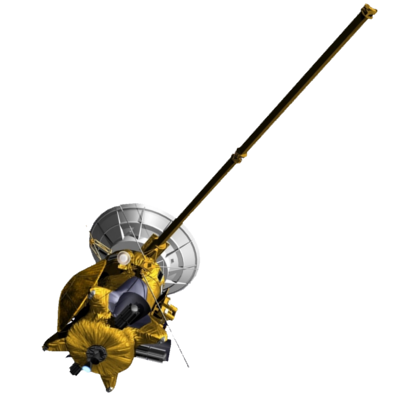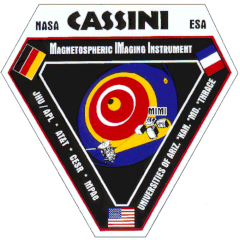CASSINI
Cassini MIMI Investigation at Fundamental Technologies
Historical MIMI Memos and Notes
(Fax from E. Kirsch to T. P. Armstrong, dated 5/26/93)
Concerning the LEMMS High Energy Detector I have the following news:
- I learned also that the 5mm thick Li-drifted Si-detectors cannot be used without bias voltage during enhanced temperature (Venus flyby). From "Ortec" I got the information that they cannot presently manufacture 5mm thick surface barrier detectors. Thus we have to use a stack of 700 micron thick Canberra detectors (=standard maximum thickness).
- I found in the literature a model calculation for Saturnian x-rays published by Barbosa (Geophys. Res. Lett., 17, 1029, 1990, fig. 2). The x-ray energies and fluxes are much smaller than expected. Thus we do not need necessarily a 5mm thick detector. Only during the high inclination orbits of Cassini would we still have a chance to detect Saturnian x-rays. I propose therefore to use for D2 a 700 micron Canberra detector (300 mm2, 9 keV FWHM noise) and for D3 two 700 micron detectors connected to one amplifier chain (300 mm2, 13 keV FWHM noise expected). D2 and D3 can then be used for x-ray detection. Such a change has also consequences for the ion and electron channels. We could also add a passive absorber in order to reach the thickness of the old design (D2 + D3 = 5300 micron S1).
May 31, 1993
Preliminary 700 μ LEMMS
| ABSORBER NAME | D1 | D2 | D3 | |||||
| ABSORBER THICKNESSES, MICRONS | 100.0 | 300.0 | 700.0 | 1400.0 | 2860.0 | 500.0 | 3307.0 | 985.0 |
| ABSORBER MATERIAL | ALUM. | SILICON | SILICON | SILICON | NICKEL | SILICON | GOLD | SILICON |
| THICKNESS VARIATION, MICRONS | 0.0 | 10.0 | 10.0 | 10.0 | 10.0 | 10.0 | 10.0 | 10.0 |
| CONICAL HALF ANGLE, DEGREES | 22.5 | 22.5 | 22.5 | 22.5 | 22.5 | 22.5 | 22.5 | 22.5 |
| DETECTOR NOISE, MEV | 0.0 | 0.015 | 0.0 | 0.015 | 0.0 | 0.010 | 0.0 | 0.010 |
| ELECTRONIC NOISE, MEV | 0.0 | 0.0 | 0.0 | 0.0 | 0.0 | 0.0 | 0.0 | 0.0 |
| NUMBER OF THRESHOLDS SET | 0.0 | 4.0 | 4.0 | 1.0 | 0.0 | 2.0 | 0.0 | 1.0 |
| THRESHOLD LEVEL NO.MEV 1 | 0.0 | 0.025 | 0.025 | 0.025 | 0.0 | 0.025 | 0.0 | 0.025 |
| THRESHOLD LEVEL NO.MEV 2 | 0.0 | 0.200 | 0.200 | 0.0 | 0.0 | 0.250 | 0.0 | 0.0 |
| THRESHOLD LEVEL NO.MEV 3 | 0.0 | 7.500 | 2.000 | 0.0 | 0.0 | 0.0 | 0.0 | 0.0 |
| THRESHOLD LEVEL NO.MEV 4 | 0.0 | 30.000 | 35.000 | 0.0 | 0.0 | 0.0 | 0.0 | 0.0 |
| THRESHOLD LEVEL NO.MEV 5 | 0.0 | 0.0 | 0.0 | 0.0 | 0.0 | 0.0 | 0.0 | 0.0 |
| THRESHOLD LEVEL NO.MEV 6 | 0.0 | 0.0 | 0.0 | 0.0 | 0.0 | 0.0 | 0.0 | 0.0 |
| THRESHOLD LEVEL NO.MEV 7 | 0.0 | 0.0 | 0.0 | 0.0 | 0.0 | 0.0 | 0.0 | 0.0 |
| THRESHOLD LEVEL NO.MEV 8 | 0.0 | 0.0 | 0.0 | 0.0 | 0.0 | 0.0 | 0.0 | 0.0 |
| THRESHOLD LEVEL NO.MEV 9 | 0.0 | 0.0 | 0.0 | 0.0 | 0.0 | 0.0 | 0.0 | 0.0 |
| THRESHOLD LEVEL NO.MEV 10 | 0.0 | 0.0 | 0.0 | 0.0 | 0.0 | 0.0 | 0.0 | 0.0 |
| AVERAGE PROJECTED DEPTH, MIC | 104.0 | 311.9 | 727.7 | 1455.4 | 2973.2 | 519.8 | 3437.8 | 1024.0 |
| EST.RMS VARN.PROJ.DEPTH, MIC | 4.1 | 12.4 | 28.8 | 57.7 | 117.8 | 20.6 | 136.2 | 40.6 |
| NET RMS THICKNESS VARN. (MIC) | 4.1 | 15.9 | 30.5 | 58.5 | 118.2 | 22.9 | 136.6 | 41.8 |
| LOWER LIMIT THICKNESS (MIC) | 99.8 | 296.0 | 697.2 | 1396.9 | 2854.9 | 496.9 | 3301.2 | 982.2 |
| UPPER LIMIT THICKNESS (MIC) | 108.1 | 327.8 | 758.2 | 1513.9 | 3091.4 | 542.7 | 3574.4 | 1065.8 |


| ABSORBER NAME | D1 | D2 | D3 | |||||
| ABSORBER THICKNESSES, MICRONS | 100.0 | 300.0 | 700.0 | 1400.0 | 2860.0 | 500.0 | 3307.0 | 985.0 |
| ABSORBER MATERIAL | ALUM. | SILICON | SILICON | SILICON | NICKEL | SILICON | GOLD | SILICON |
| THICKNESS VARIATION, MICRONS | 0.0 | 10.0 | 10.0 | 10.0 | 10.0 | 10.0 | 10.0 | 10.0 |
| CONICAL HALF ANGLE, DEGREES | 22.5 | 22.5 | 22.5 | 22.5 | 22.5 | 22.5 | 22.5 | 22.5 |
| DETECTOR NOISE, MEV | 0.0 | 0.015 | 0.0 | 0.015 | 0.0 | 0.010 | 0.0 | 0.010 |
| ELECTRONIC NOISE, MEV | 0.0 | 0.0 | 0.0 | 0.0 | 0.0 | 0.0 | 0.0 | 0.0 |
| NUMBER OF THRESHOLDS SET | 0.0 | 4.0 | 4.0 | 1.0 | 0.0 | 2.0 | 0.0 | 1.0 |
| THRESHOLD LEVEL NO.MEV 1 | 0.0 | 0.025 | 0.025 | 0.025 | 0.0 | 0.025 | 0.0 | 0.025 |
| THRESHOLD LEVEL NO.MEV 2 | 0.0 | 0.200 | 0.200 | 0.0 | 0.0 | 0.250 | 0.0 | 0.0 |
| THRESHOLD LEVEL NO.MEV 3 | 0.0 | 7.500 | 2.000 | 0.0 | 0.0 | 0.0 | 0.0 | 0.0 |
| THRESHOLD LEVEL NO.MEV 4 | 0.0 | 30.000 | 35.000 | 0.0 | 0.0 | 0.0 | 0.0 | 0.0 |
| THRESHOLD LEVEL NO.MEV 5 | 0.0 | 0.0 | 0.0 | 0.0 | 0.0 | 0.0 | 0.0 | 0.0 |
| THRESHOLD LEVEL NO.MEV 6 | 0.0 | 0.0 | 0.0 | 0.0 | 0.0 | 0.0 | 0.0 | 0.0 |
| THRESHOLD LEVEL NO.MEV 7 | 0.0 | 0.0 | 0.0 | 0.0 | 0.0 | 0.0 | 0.0 | 0.0 |
| THRESHOLD LEVEL NO.MEV 8 | 0.0 | 0.0 | 0.0 | 0.0 | 0.0 | 0.0 | 0.0 | 0.0 |
| THRESHOLD LEVEL NO.MEV 9 | 0.0 | 0.0 | 0.0 | 0.0 | 0.0 | 0.0 | 0.0 | 0.0 |
| THRESHOLD LEVEL NO.MEV 10 | 0.0 | 0.0 | 0.0 | 0.0 | 0.0 | 0.0 | 0.0 | 0.0 |
| AVERAGE PROJECTED DEPTH, MIC | 104.0 | 311.9 | 727.7 | 1455.4 | 2973.2 | 519.8 | 3437.8 | 1024.0 |
| EST.RMS VARN.PROJ.DEPTH, MIC | 4.1 | 12.4 | 28.8 | 57.7 | 117.8 | 20.6 | 136.2 | 40.6 |
| NET RMS THICKNESS VARN. (MIC) | 4.1 | 15.9 | 30.5 | 58.5 | 118.2 | 22.9 | 136.6 | 41.8 |
| LOWER LIMIT THICKNESS (MIC) | 99.8 | 296.0 | 697.2 | 1396.9 | 2854.9 | 496.9 | 3301.2 | 982.2 |
| UPPER LIMIT THICKNESS (MIC) | 108.1 | 327.8 | 758.2 | 1513.9 | 3091.4 | 542.7 | 3574.4 | 1065.8 |


 |
Figure 1 |
 |
Figure 2 |
 |
Figure 3 |
 |
Figure 4 |
 |
Figure 5 |
 |
Figure 6 |
 |
Figure 7 |
 |
Figure 8 |
 |
Figure 9 |
 |
Figure 10 |
 |
Figure 11 |
 |
Figure 12 |
Return to Historical MIMI Notes and Memos main page.
Return to Cassini
MIMI table of contents page.
Return to Fundamental
Technologies Home Page.
Updated 8/8/19, Cameron Crane
QUICK FACTS
Manufacturer: The Cassini spacecraft
was manufactured by NASA's Jet Propulsion Laboratory,
and the Huygens Probe was manufactured by Thales Alenia
Space.
Mission Duration: The Cassini-Huygens mission launched on October 15 1997, and ended on September 15 2017.
Destination: Cassini's destination was Saturn and its moons. The destination of the Huygens Probe's was Saturn's moon Titan.
Orbit: Cassini orbited Saturn for 13 years before diving between its rings and colliding with the planet on September 15th, 2017.
Mission Duration: The Cassini-Huygens mission launched on October 15 1997, and ended on September 15 2017.
Destination: Cassini's destination was Saturn and its moons. The destination of the Huygens Probe's was Saturn's moon Titan.
Orbit: Cassini orbited Saturn for 13 years before diving between its rings and colliding with the planet on September 15th, 2017.



